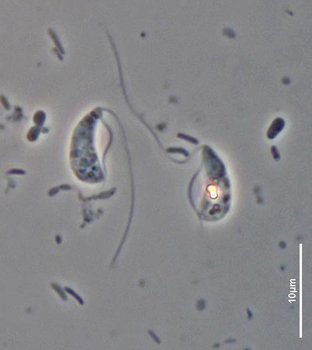Andalucia
Alastair Simpson- Andalucia godoyi
- Andalucia incarcerata
Introduction
Andalucia is a recently described group of jakobid flagellates. There are two described species, Andalucia godoyi Lara et al., 2006, and Andalucia incarcerata (Bernard et al., 2000) Lara et al., 2006, previously known as Jakoba incarcerata. Phylogenetic studies indicate that Andalucia is a sister group to other studied jakobids (Lara et al. 2006; Simpson et al., 2008; Hampl unpublished), and is of potential evolutionary interest.
Characteristics
Andalucia godoyi and A. incarcerata are small biflagellated, free-swimming cells with a ventral feeding groove. They resemble Jakoba, and in fact there are no morphological features identified to date that unify Andalucia or clearly distinguish Andalucia from Jakoba (Lara et al., 2006). For example, Andalucia godoyi has tubular mitochondrial cristae while Jakoba libera has flattened cristae, however, Andalucia incarcerata lacks mitochondrial cristae altogether (Simpson and Patterson, 2001; Lara et al., 2006).
Andalucia godoyi was isolated recently from soil in Europe (Lara et al., 2006). It is small (3-5 μm), and the flagella are about twice the length of the cell body. It has not been observed to attach to surfaces by the anterior flagellum. Andalucia godoyi readily forms rounded cysts in culture (Lara et al., 2006).
Andalucia incarcerata has been isolated from the anoxic layers at intertidal marine sites from Australia and North America (Bernard et al., 2000; Simpson et al., 2008). This species is most likely a microaerophile. Most cells are 6-8 μm (Simpson and Patterson, 2001). In many cells the anterior flagellum is rather shorter than the cell body, while the posterior flagellum is somewhat longer, and the groove is conspicuous. These cells can attach to surfaces by the anterior flagellum during feeding (as per Jakoba libera). In culture many cells instead have an elongated anterior flagellum that is usually directed laterally and posteriorly and is often held in a stiff curve (see the title illustration, and Simpson and Patterson, 2001). The mitochondrial organelles of Andalucia incarcerata lack cristae (Simpson and Patterson, 2001). It is possible that these organelles may lack a complete electron transport chain, and might function as hydrogenosomes or some other form of atypical mitochondrial organelle, although investigations are not complete.
Discussion of Phylogenetic Relationships
Phylogenies of small subunit ribosomal RNA genes and of 6-7 concatened protein sequences strongly support the monophyly of Andalucia to the exclusion of other jakobids (Lara et al., 2006; Simpson et al., 2008). Environmental PCR studies have revealed a number of SSUrRNA gene sequences that fall within the Andalucia clade in phylogenetic analyses. While some of these correspond closely to Andalucia incarcerata, others are relatively dissimilar to both A. incarcerata and A. godoyi, and likely represent (three or more) so-far uncultured species of Andalucia (see Simpson et al., 2008).
References
Bernard, C., Simpson, A. G. B. & Patterson, D. J. (2000) Some free-living flagellates (Protista) from anoxic habitats. Ophelia 52: 113-142.
Lara, E., Chatzinotas, A., Simpson, A.G.B. (2006) Andalucia (gen. nov,): a new taxon for the deepest branch within jakobids (Jakobida; Excavata), based on morphological and molecular study of a new flagellate from soil. J. Eukaryot. Microbiol. 53: 112-120.
Simpson, A.G.B. & Patterson, D.J. (2001) On core jakobids and excavate taxa: the ultrastructure of Jakoba incarcerata. J. Eukaryot. Microbiol. 48: 480-492.
Simpson, A.G.B., Perley, T. & Lara, E., (2008) Lateral transfer of the gene for a widely used marker, alpha tubulin, indicated by a multi-protein study of the phylogenetic position of Andalucia (Excavata). Mol. Phylogenet. Evol. 47: 366-377.
Title Illustrations

| Scientific Name | Andalucia incarcerata, isolate MB |
|---|---|
| Specimen Condition | Live Specimen |
| Image Use |
 This media file is licensed under the Creative Commons Attribution-NonCommercial License - Version 3.0. This media file is licensed under the Creative Commons Attribution-NonCommercial License - Version 3.0.
|
| Copyright |
© Alastair Simpson

|
About This Page
This page is being developed as part of the Tree of Life Web Project Protist Diversity Workshop, co-sponsored by the Canadian Institute for Advanced Research (CIFAR) program in Integrated Microbial Biodiversity and the Tula Foundation.
Alastair Simpson

Dalhousie University, Halifax, Nova Scotia, Canada
Correspondence regarding this page should be directed to Alastair Simpson at
Page copyright © 2008 Alastair Simpson
 Page: Tree of Life
Andalucia .
Authored by
Alastair Simpson.
The TEXT of this page is licensed under the
Creative Commons Attribution-NonCommercial License - Version 3.0. Note that images and other media
featured on this page are each governed by their own license, and they may or may not be available
for reuse. Click on an image or a media link to access the media data window, which provides the
relevant licensing information. For the general terms and conditions of ToL material reuse and
redistribution, please see the Tree of Life Copyright
Policies.
Page: Tree of Life
Andalucia .
Authored by
Alastair Simpson.
The TEXT of this page is licensed under the
Creative Commons Attribution-NonCommercial License - Version 3.0. Note that images and other media
featured on this page are each governed by their own license, and they may or may not be available
for reuse. Click on an image or a media link to access the media data window, which provides the
relevant licensing information. For the general terms and conditions of ToL material reuse and
redistribution, please see the Tree of Life Copyright
Policies.
- First online 05 September 2008
- Content changed 05 September 2008
Citing this page:
Simpson, Alastair. 2008. Andalucia . Version 05 September 2008. http://tolweb.org/Andalucia/125098/2008.09.05 in The Tree of Life Web Project, http://tolweb.org/









 Go to quick links
Go to quick search
Go to navigation for this section of the ToL site
Go to detailed links for the ToL site
Go to quick links
Go to quick search
Go to navigation for this section of the ToL site
Go to detailed links for the ToL site